 |
 |
 |
| |
Pitavastatin Has No Effect on Long-Term, Objective Physical Function in REPRIEVE
|
| |
| |
Pitavastatin for 5 Years Does Not Harm Physical Function in HIV Group
CROI 2024 (Conference on Retroviruses and Opportunistic Infections), March 3-6, 2024, Denver
Mark Mascolini
Despite concerns about myalgia with long-term use of statins by people with HIV, 5-year analysis of REPRIEVE trial participants found minimal physical function change with pitavastatin or placebo in 602 middle-aged people with HIV infection [1]. These findings held true across subgroups defined by demographic and HIV-related factors.
After a median follow-up of 5.1 years, the placebo-controlled REPRIEVE trial found that 4 mg of pitavastatin daily cut the risk of a major cardiovascular event 35% in middle-aged people with HIV and low to moderate cardiovascular disease risk [2]. REPRIEVE participants could also enroll in the PREPARE substudy when they began treatment (the prospective group) or within 2 years of starting randomized treatment in REPRIEVE (the retrospective group).
PREPARE aimed to track changes in long-term physical function with pitavastatin [3]. Studies in the general population suggest that statins may slow waning physical function, but these studies were observational, assessed physical function subjectively, or had only 1 year of follow-up. With longer follow-up of 602 people with HIV, Kristine Erlandson (University of Colorado) and PREPARE coworkers hypothesized that physical function would wane over time but that pitavastatin would slow this decline.
Researchers gauged physical function every year by assessing 4-meter gait, balance, grip strength, rising from a chair 10 times, and the manual short physical performance battery (mSPPB). Among 602 REPRIEVE participants who enrolled in PREPARE, 45% were in the prospective group and 55% in the retrospective group. People randomized to pitavastatin did not differ from those assigned to placebo in physical function when they entered the study. Median follow-up reached 5 years in the prospective group and 4.4 years in the retrospective group. Four in 5 PREPARE participants (81%) completed follow-up.
In the PREPARE substudy population, 316 people randomized to pitavastatin were similar to 286 people assigned to placebo in median age (51 years in both groups), body mass index (27.3 kg/m2 pitavastatin and 27.1 kg/m2 placebo), and proportions of females (21% and 16%), transgender people (2% and 2%), blacks (40% and 39%), Hispanics (18% and 18%), and current smokers (30% and 24%).
Over the years of study, chair rise rate declined minimally in the pitavastatin group and the placebo group, with no difference between pitavastatin and placebo and similar results when researchers limited the analysis to the prospective group. Overall drop in chair rise rate was less than the anticipated -0.58 rises/minute/year. Actual annualized changes measured -0.03 rises/min/year in people taking the statin.
Gait speed also fell slowly and similarly in people randomized to pitavastatin or placebo (-0.1 meter/second for both). PREPARE investigators noted that the smallest clinically meaningful change in gait speed is 0.03 to 0.05 meter/second and that the recorded change per year of age stands at 0.012 meter/second/year in people with HIV.
Change in grip strength was also small and equivalent with pitavastatin and placebo (-0.40 and -0.37 kg per year). The smallest clinically meaningful change in grip strength is estimated at 5.0 to 6.5 kg, and the change per year of age in people with HIV ranges from 0.37 to 0.40 kg/year.
None of the 8 physical function measures (including mSPPB and multiple measures of chair rise, gait speed, and grip strength) differed significantly between the pitavastatin group and the placebo group in PREPARE.
PREPARE investigators recorded 15 grade 3 or higher adverse events or treatment changes caused by muscle symptoms in people taking pitavastatin and 13 in those taking placebo (4.7% and 4.5%). These findings proved consistent across subgroups defined by age, sex, race, antiretroviral duration, CD4 count, physical function when entering the trial, or self-reported muscle symptoms. The study disclosed no differences in physical function measures before or after visits during the COVID pandemic.
The investigators noted that their findings are limited by enrollment confined to the United States, female enrollment below 20%, and age below 55 years for most participants (only 8% were 60 or older). They suggested that statins may affect physical function differently in people living with HIV in low- and middle-income countries, older people, and in people with a high risk of cardiovascular disease.
Erlandson and colleagues concluded that “in combination, these findings support the long-term safety of statin therapy on muscle, when used for primary prevention among people with HIV.”
CROI: Effects of Semaglutide on Muscle Structure and Function in the SLIM Liver Study - (03/12/24)
References
1. Erlandson KM, Umbleja T, Ribaudo HJ, et al. Pitavastatin has no effect on long-term, objective physical function in REPRIEVE. CROI 2024 (Conference on Retroviruses and Opportunet al. Pitavastatin has no effect on long-term, objective physical function in REPRIEVEistic Infections), March 3-6, 2024, Denver. Abstract 152.
2. Grinspoon SK, Fitch KV, Zanni MV, et al. Pitavastatin to prevent cardiovascular disease in HIV infection. N Engl J Med. 2023;389:687-699. doi: 10.1056/NEJMoa2304146. https://www.nejm.org/doi/10.1056/NEJMoa2304146
3, ClinicalTrials.gov. PREPARE (A5361s) substudy of REPRIEVE (A5332) (PREPARE). ClinicalTrials.gov ID NCT03070223. https://clinicaltrials.gov/study/NCT03070223
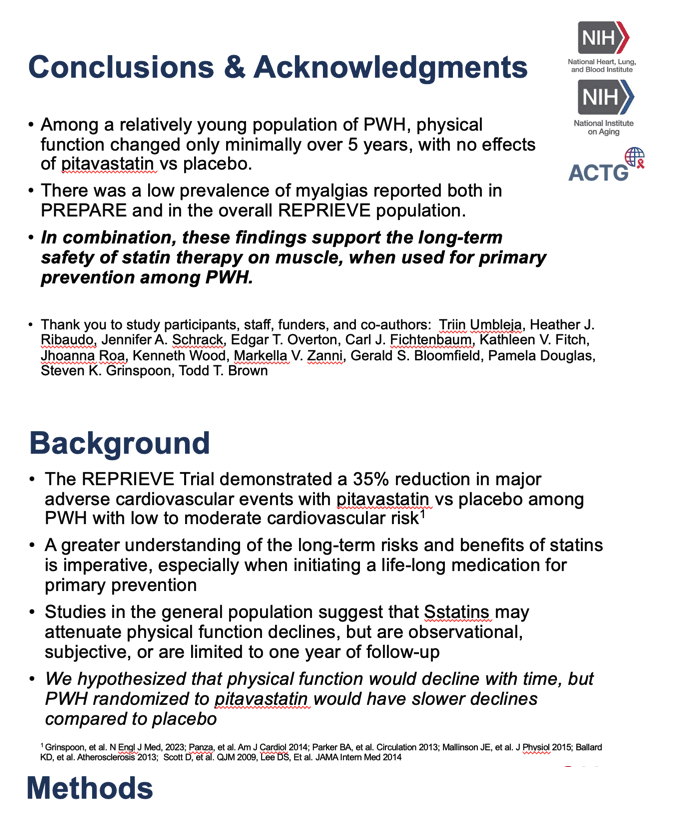
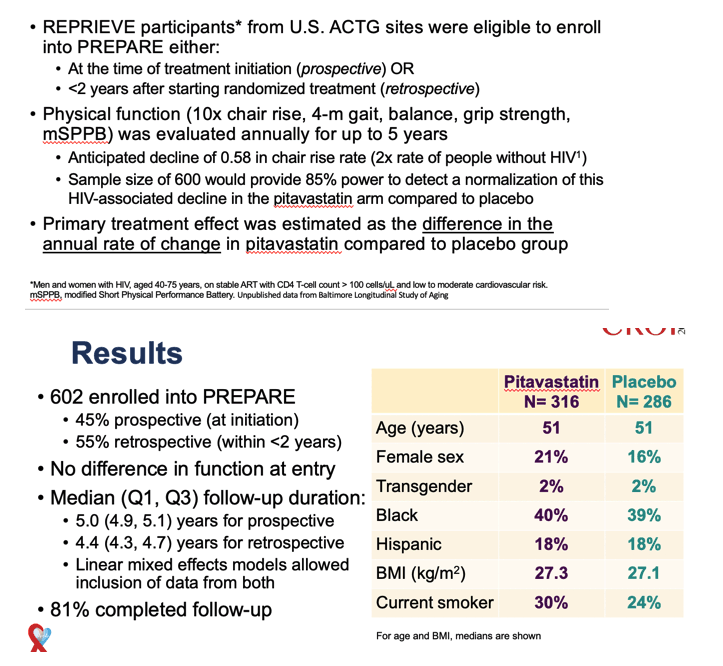
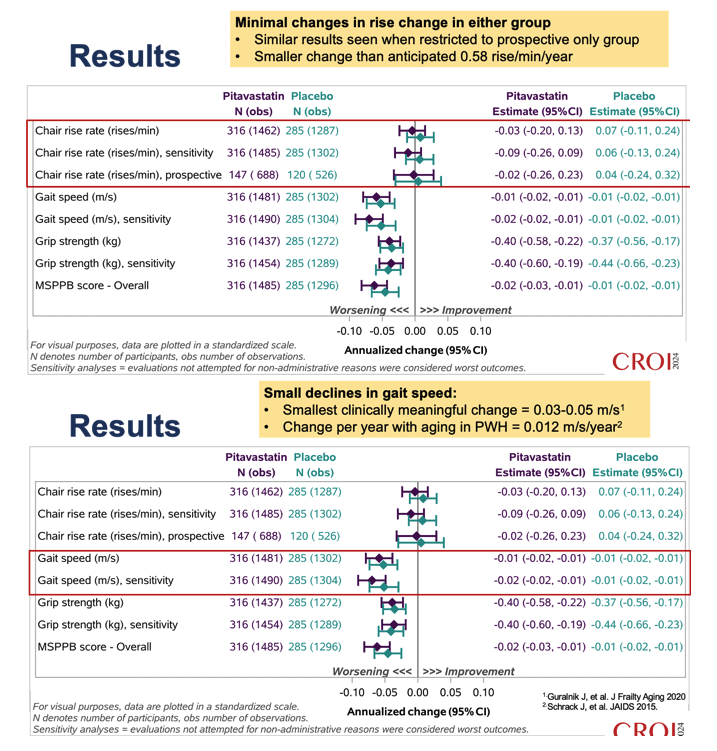
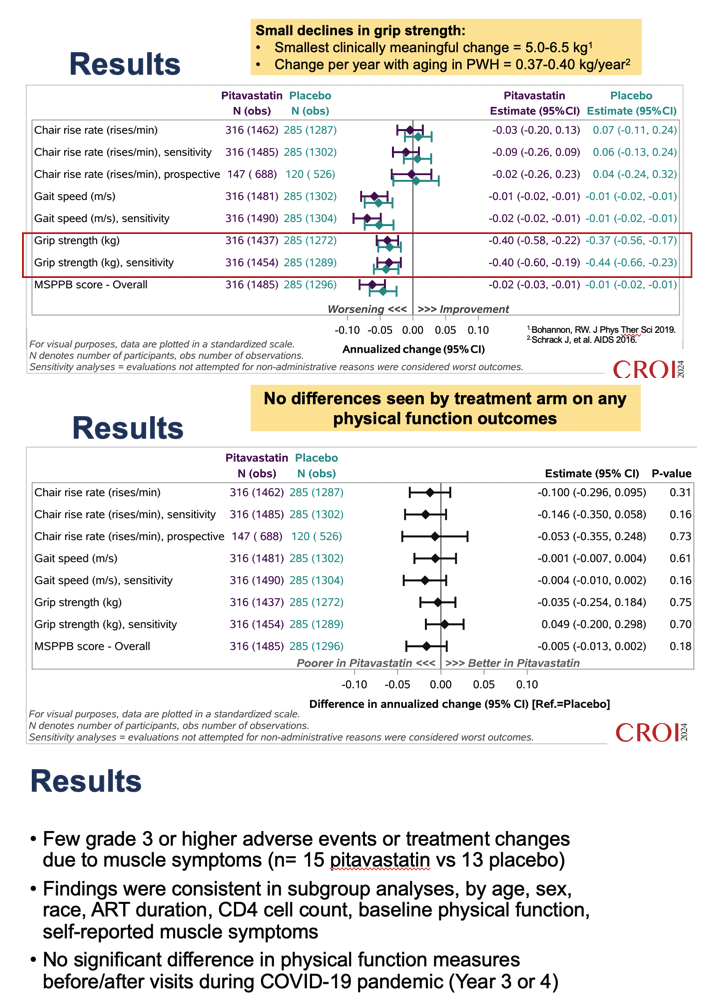
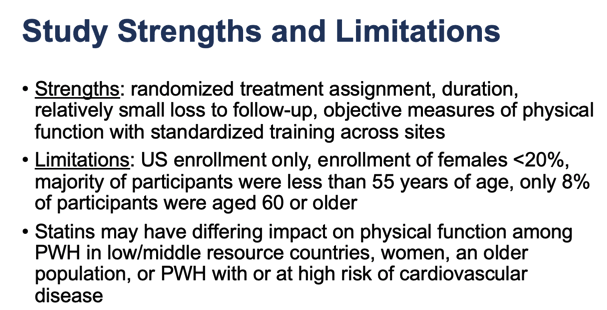
Semaglutide at CROI 2024
the use of semagltude is found to cause muscle loss in PWH in these studies, as well as worsening already existing or causing facial & limb fat loss/lipoatrphy, this this becomes a concern for WPWH aging were muscle & fat changes or loss can be impactful.
• CROI: Impact of Semaglutide on Weight Change Among People with HIV: A Stratified Analysis by Baseline BMI - (03/11/24)
CROI: Effects of Semaglutide on Muscle Structure and Function in the SLIM Liver Study - (03/12/24)
• CROI: Semaglutide Lowers Some Inflammation Markers in HIV Lipohypertrophy - (03/12/24)
CROI: Effects of Semaglutide on Inflammation and Immune Activation in HIV-Associated Lipohypertrophy....people with severe lipoatrophy were excluded from study, so were diabetics & CVD - (03/11/24)
• CROI: Effects of Semaglutide on Muscle Structure and Function in the SLIM Liver Study - (03/12/24)
• CROI: Semaglutide Lowers Some Inflammation Markers in HIV Lipohypertrophy - (03/12/24)
• CROI: Low-Dose Semaglutide Cuts Weight, Triglycerides, and Glucose in HIV MASLD Group - (03/12/24)
• CROI: Race/Ethnicity and Risk of NAFLD and Clinically Significant Fibrosis in Persons Living with HIV - (03/12/24)
• CROI: NAFLD and Advanced Fibrosis Are Common in Adults With HIV and Associated With Unique Histology - (03/12/24)
CROI: Weight Loss 5.7% at 1 Year With Semaglutide in HIV - Mark Mascolini (03/11/24)
100 NATAP CROI Reports
Conference on Retroviruses
and Opportunistic Infections Virtual
Mar 3 -, Mar 6, 2024
|
| |
|
 |
 |
|
|